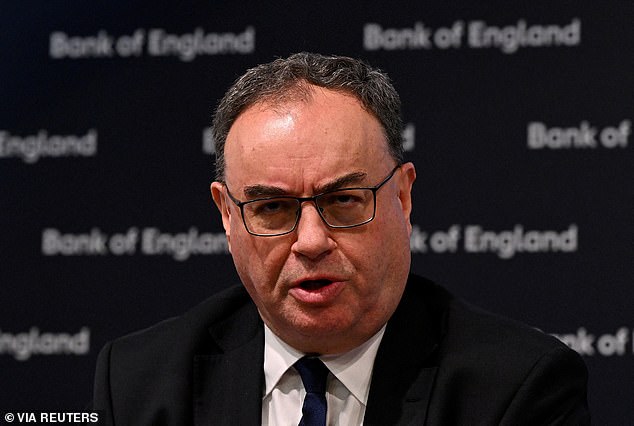The governor of the Bank of England last night forecast another big drop in inflation after it fell to the lowest level since September 2021.
Slower increases in food prices helped Consumer Price Index inflation fall to 3.2 percent last month from 3.4 percent in February.
And Andrew Bailey told his fellow bankers in Washington that the gauge is likely to see a sharp decline when April figures are released.
“I expect next month’s data to show a fairly sharp decline due to the impact of changes in energy prices,” he said during a conference organized by the Institute of International Finance.
Andrew Bailey (pictured) told fellow bankers in Washington that the indicator is likely to see a sharp drop when April figures are published.
His optimism is sure to increase speculation that Britain could get ahead of the United States by cutting interest rates from the current level of 5.25 percent sooner rather than later.
UK inflation is now below the US rate for the first time since 2022.
But the latest reading was higher than markets expected, denting hopes of an interest rate cut by the Bank of England this summer.
Jeremy Hunt said falling inflation showed “the scheme is working… helping people’s money go further” and helping to boost household finances thanks to cuts to National Insurance.
“People should start to feel the difference and see it in their paychecks,” the Chancellor said.
And in an interview with the Financial Times, he said the Government would like to reduce taxes this autumn “if we can”.
Falling inflation brings relief to millions of households after a painful period in which it hit a four-decade high of 11.1 percent amid skyrocketing energy and food prices.
It is expected to fall to the Bank of England’s 2 percent target this spring. Energy prices have generally been falling, while food price inflation – which hit 19 percent a year ago – has dropped to a more palatable 4 percent.
However, those effects were partially offset by rising fuel prices in last month’s data.
The fall in headline inflation means that, while prices continue to rise, they do so less steeply.
And, more importantly, wages are rising faster (6 percent, according to figures released this week), meaning working households will feel better.
Markets expected inflation to fall a little more than it did, to 3.1 percent.
The smaller-than-expected drop led traders to bet that there was a less than 50/50 chance of a rate cut in August, pushing the likely timing to September.
Business groups, pressured by high borrowing costs, want the Bank to act sooner rather than later.
Roger Barker, policy director at the Institute of Directors, said “the trend is clear” of falling inflation and argued there was a case for the Bank to cut rates soon.
Simon Pittaway, of the Resolution Foundation, said: “Inflation should soon reach its target again and pressure to cut interest rates will increase.”


